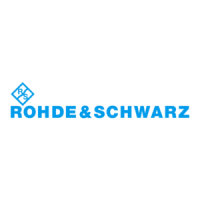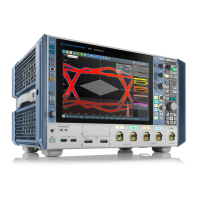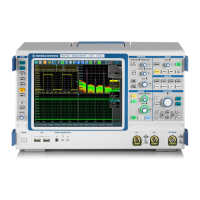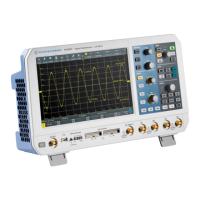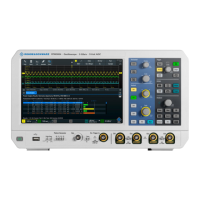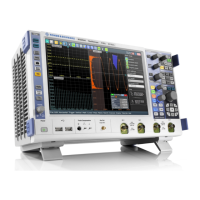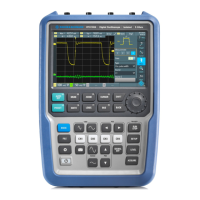Triggers
R&S
®
RTE
270User Manual 1326.1032.02 ─ 20
Trigger out signal setup
Defines the pulse that is provided to the [TRIGGER OUTPUT] connector on the rear
panel.
A trigger out pulse can be provided either when a trigger occurs, or when a mask test
violation occurs, or when a limit check violation in a measurement occurs.
"Enable trigger
out"
Generates the trigger out signal on trigger event.
The setting is not available if:
●
A mask test is running with "Trigger Out Pulse" set to "On viola-
tion".
●
A measurement running with limit check enabled and "Trigger Out
Pulse" set to "On violation".
"Polarity"
Sets the polarity of the trigger out pulse, that is the direction of the
first pulse edge.
"Pulse length"
Sets the length of the trigger out pulse.
"Delay"
Sets the delay of the first pulse edge to the trigger point. The setting
is only available if "Enable trigger out" is active.
Remote command:
TRIGger<m>:OUT:STATe on page 1207
TRIGger<m>:OUT:POLarity on page 1207
TRIGger<m>:OUT:PLENgth on page 1208
TRIGger<m>:OUT:DELay on page 1208
6.7 Sequence
A trigger sequence consists of at least one trigger condition and additional conditions
defining when the trigger occurs.
A only
The simple sequence "A only" only contains the A-trigger condition.
A → B
The trigger sequence "A → B" consists of two subsequent conditions: A-trigger and B-
trigger, an optional delay and an optional setting to count B-triggers. A- and B-triggers
are configured in the same way.
After the A-trigger conditions have been met and an optional delay has passed, the B-
trigger with independent conditions is enabled. The instrument waits until one or a
specified number of B-trigger conditions occur. The latest B-trigger causes the trigger
event, and then the sequence starts again. The B-trigger can only cause the trigger
event if it occurs after the A-trigger and after the delay time.
The "A → B" trigger sequence requires that input channels CH1 to CH4 are set as trig-
ger sources for all conditions. All other input sources are disabled.
Sequence
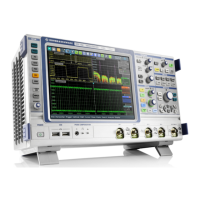
